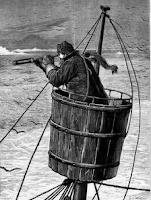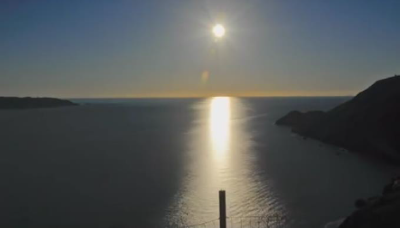86. The Cape Bonavista Light at a height of 150 feet should not be visible from a ship 35 miles away on a spherical Earth
“The light at Cape Bonavista, Newfoundland is 150 feet above sea-level and visible at 35 miles, where it should be 491 feet below the horizon.”
Probably a bogus observation, but in any case Dubay and Samuel Rowbotham can't do trigonometry.
For evidence that the quoted observation is bogus, click here:
Why Dubay's lighthouse quotes are bogus
However, if you want to take the observation as genuine read on to see why this still does not add up to a proof.
The focal height of the light is actually 167 feet not 150.
Using the correct figure and calculation, the observer on the ship would have to be at a height of 245 feet. From the deck of a ship that would mean that the observer would be about 239 feet too low to see the lighthouse.
However, as with so many of Dubays "proofs" this is taken from Samuel Rowbotham's "Zetetic Astronomy: Earth Not a Globe" published in 1881.
The relevant paragraphs from the book are:

In 1881 the ships that would be observing the lighthouse would be sailing ships or steam ships that still had sails as a back-up. Look-outs on those ships would be placed in a crows nest near the top of the main mast.
The tallest ship of that period that I have found places the top of the mast about 200 feet above sea level. See: https://en.wikipedia.org/wiki/Great_Republic
 Rowbotham does not gives us a source for his claim of 35 miles, so there is no way of validating how accurate the claim is.
Rowbotham does not gives us a source for his claim of 35 miles, so there is no way of validating how accurate the claim is.
However if we take refraction into account, by my calculation for a typical refractive index the required elevation reduces to 183 feet. If Rowbotham's 35 miles was based on a single account, it is possible that it could have been a sighting from a large ship with a tall mast.
As the possibility exists for a sighting on a spherical Earth, and we have no confirmation as to whether the 35 mile figure was a general claim or a specific observation this historical observation cannot be considered a proof.
There is also good reason to believe that all these observations of distant lighthouse sightings are bogus.
For details click the link below.
Why Dubay's lighthouse quotes are bogus
< Prev 81-90 Next >
Probably a bogus observation, but in any case Dubay and Samuel Rowbotham can't do trigonometry.
For evidence that the quoted observation is bogus, click here:
Why Dubay's lighthouse quotes are bogus
However, if you want to take the observation as genuine read on to see why this still does not add up to a proof.
The focal height of the light is actually 167 feet not 150.
Using the correct figure and calculation, the observer on the ship would have to be at a height of 245 feet. From the deck of a ship that would mean that the observer would be about 239 feet too low to see the lighthouse.
However, as with so many of Dubays "proofs" this is taken from Samuel Rowbotham's "Zetetic Astronomy: Earth Not a Globe" published in 1881.
"Many instances could be given of lights being visible at sea for distances which would be utterly impossible upon a globular surface of 25,000 miles in circumference. The following are examples:-
....
Allowing 16 feet for the altitude of the observer .....
The light on Cape Bonavista, Newfoundland, is 150 feet above high water, and is visible 35 statute miles. These figures will give on calculating earth's rotundity, 491 feet as the distance it should be sunk below the sea horizon."

In 1881 the ships that would be observing the lighthouse would be sailing ships or steam ships that still had sails as a back-up. Look-outs on those ships would be placed in a crows nest near the top of the main mast.
"... masts were still to be found on many merchant and passenger ships well into the 1900s"
Source: https://www.uh.edu/engines/epi1338.htmHowever, even taking into account sightings from the ship's mast observers on large ships would not achieve the required 245 feet of elevation to meet Rowbotham's claim that the light was visible from 35 miles away.
The tallest ship of that period that I have found places the top of the mast about 200 feet above sea level. See: https://en.wikipedia.org/wiki/Great_Republic

However if we take refraction into account, by my calculation for a typical refractive index the required elevation reduces to 183 feet. If Rowbotham's 35 miles was based on a single account, it is possible that it could have been a sighting from a large ship with a tall mast.
As the possibility exists for a sighting on a spherical Earth, and we have no confirmation as to whether the 35 mile figure was a general claim or a specific observation this historical observation cannot be considered a proof.
There is also good reason to believe that all these observations of distant lighthouse sightings are bogus.
For details click the link below.
Why Dubay's lighthouse quotes are bogus
< Prev 81-90 Next >





Comments
Post a Comment